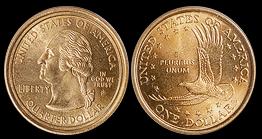
2000-P SACAGAWEA DOLLAR/QUARTER
DOLLAR MULE
(PHOTO COURTESY OF
FRED
WEINBERG)
2000-P Sacagawea Dollar/Quarter Dollar Mules |
|
What was previously thought to be an impossible error in U.S. coinage, proved to be possible in May 2000. Frank Wallis of Arkansas was looking through a roll of Sacagawea Dollars when he found what is refered to as a "mule". A "mule" in numismatic terms is defined as a coin that is struck with a pair of dies that weren't intended to be paired together. In this case, a States Quarter Dollar obverse and a Sacagawea Dollar reverse were used together. It was struck on a golden dollar planchet. Although mules are found on coinage throughout the world, this is the first time one was found on a U.S. coin. When first discovered, the Sacagawea Dollar/Quarter Dollar mule was widely publicized in newspapers, magazines, and on television shows such as Good Morning America and CNN Headline News. To date, only seventeen confirmed Sacagawea Dollar/Quarter Dollar mules have been found and authenticated. The date does not appear on either the obverse or reverse of these pieces, but they are determined to have been produced in 2000 since they were first discovered in the calendar year 2000, which was the first year of issue for the Sacagawea Dollar. Had they been found in 2001 or later, the date would not have been discernable.
The
following was reported by Fred
Weinberg on Collectors
Universe -- U.S. Coin Forum on
7/12/2016. When they first came out, the Mint reported that they destroyed the coins in the bins on EITHER side of the press that made the Mules, just in case a few of the "Center Press" Mules where thrown into the wrong bin either to the left or right side of the center press. However, after a few came out, Dave Camire of NGC determined that there were three different die pairings - and that was the real reason three bins worth or coins were destroyed. The story I heard from a reliable source was that due to OSHA rules, the Mint, starting around 1998/1999, was supposed to rotate certain employees to different jobs within the Mint. I don't know when or how long the job changes occurred. One day in April (or very early in May) of 2000, someone was in the Die Room, having been rotated to that position from another position they held at the Mint. When a pressman came to the Die Room, they requested an Obverse Die for the Sacagawea Dollar. It was handed to them in a plastic die cover (used in all the Mints to protect from dust and other contaminates), and they took the die to the Sac. $1 Press, installed it in the upper die (Hammer) position, took off the plastic die cap, and started striking coins. It turns out the die given to that person was a George Washington State Quarter Die, and it was not noticed until the Mules were found in that press's bin. Remember the problem the public had back in 1979 with the newly issued SBA dollars - the size problem? Apparently, the Mint had the same size confusion with the Dies...... Now, although it's possible that the above scenario took place with three different Presses' at the same time, there is no way to prove it....Could Die Pairing # 2 and # 3 be from the same day, or were they “copycat” errors, made days later, after word got around what had occurred?? We don't know. |
In the summer of 2000, just before the ANA Convention in Philadelphia where the "Discovery Specimen" was to be sold at auction, an uninstantiated story appeared in a prominent numismatic publication. The story stated that a Michigan dealer had reported that someone brought into his shop 10 to 12 mule Sacagawea Dollar/Quarter Dollar coins. The dealer stated that the person had gotten them in change from a stamp machine at the local post office. According to Fred Weinberg "It was a ridiculous claim....., think about it - if the person received 10-12 Mules back in change, what were the odds that either ALL of the dollar coins in the stamp machine were Mules, but not another coin was ever found or reported? If the report was one or two Mules found in the machine, as change, it would have been believable, but not that quantity - all in a row, all in order, all coming out as one after the other as part of this person's change - but no other Mule coins at all! ..... and as it turned out, the coins did not exist....." Noted numismatic author Tom DeLorey states "As a result of this unverified report of a hoard existing, the coin sold for much less than expected. It was speculated at the time that somebody may have spread a false rumor to influence the bidding to allow them to buy it cheaper. I am sure that that was never proven." The coin ended up selling for $29,900 at the ANA Auction. Fred says "I always thought that if that article had never been published, the Discovery coin would have brought at least $75K, maybe $100K or more."
Many novelty pieces have been manufactured outside the Mint by hollowing out a Sacagawea Dollar and inserting a Washington Quarter. The pieces are then plated a golden color to closely match the dollar. They should be easily distinguishable from genuine pieces due to improper weight, a seam where the two coins meet, and noticeable "golden" plating. Authentication of genuine pieces is mandatory.
To read more about the sixteen of the seventeen confirmed pieces, visit Fred Weinberg's "Error News" Page.